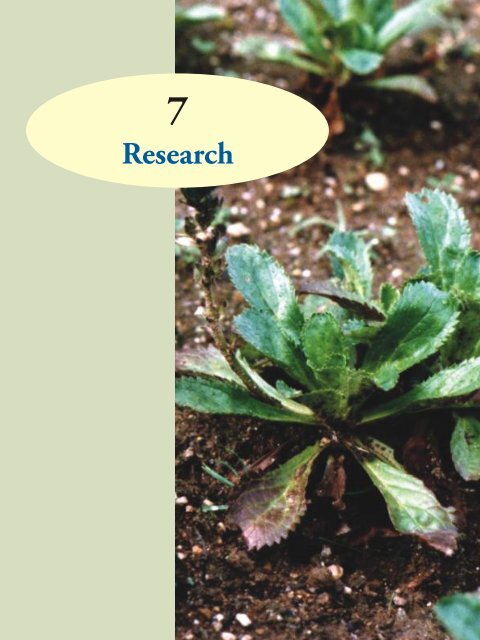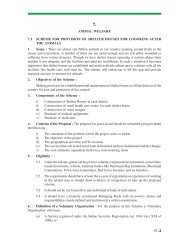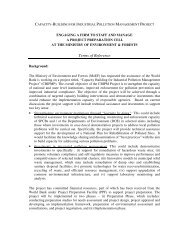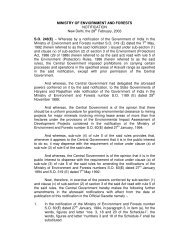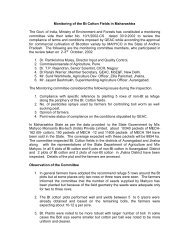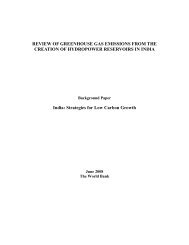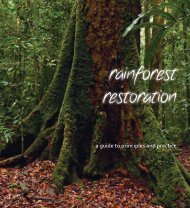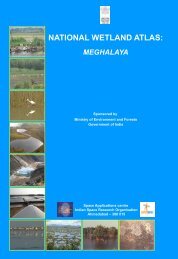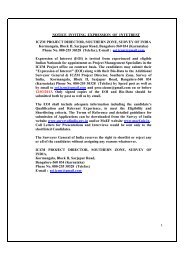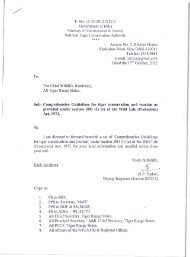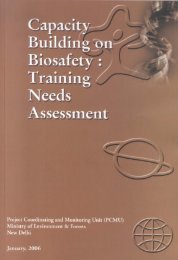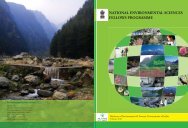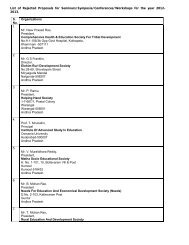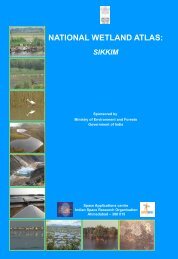Research - Ministry of Environment and Forests
Research - Ministry of Environment and Forests
Research - Ministry of Environment and Forests
You also want an ePaper? Increase the reach of your titles
YUMPU automatically turns print PDFs into web optimized ePapers that Google loves.
Annual Report 2006-2007<strong>Environment</strong>al <strong>Research</strong> <strong>and</strong> DevelopmentIntroduction <strong>and</strong> Objective<strong>Ministry</strong> has been funding research in multidisciplinaryaspects for environmental <strong>and</strong>ecosystems protection, conservation <strong>and</strong>management at various universities, institutions <strong>of</strong>higher learning, national research institutes <strong>and</strong>non-governmental organizations in identified thrustareas under its <strong>Research</strong> & Development (R&D)Programme. The <strong>Research</strong> & Development Scheme<strong>of</strong> the <strong>Ministry</strong> is a Central Plan Scheme forconservation <strong>and</strong> management <strong>of</strong> environmentsince 1985 <strong>and</strong> is looked after by <strong>Research</strong> &Ecoregeneration (RE) Division <strong>of</strong> the <strong>Ministry</strong>.The objectives <strong>of</strong> the scheme are to generateinformation required to develop strategies,technologies <strong>and</strong> methodologies for betterenvironmental management. It also aims atattempting solutions to the practical problems <strong>of</strong>resource management, conservation <strong>of</strong> naturalresources <strong>and</strong> eco-regeneration <strong>of</strong> degraded areas.Further, the scheme also aims at strengtheninginfrastructure to facilitate research <strong>and</strong> scientificmanpower development.Progress <strong>of</strong> Various ActivitiesDuring the year <strong>Ministry</strong> brought out newguidelines for supporting research clearly indicatingthe order <strong>of</strong> priority <strong>and</strong> broad research themes tobe supported in the identified thrust areas in thefollowing three modes:-✦✦✦Suo-moto proposals, which can be submittedat any time <strong>of</strong> the year.Competitive invited proposals to besubmitted when called for depending uponthe specific needs <strong>of</strong> policy making includinginformation required for internationalnegotiations <strong>and</strong> implementation <strong>of</strong> planschemes. Selection among the proposalsreceived in response is made competitively onthe basis <strong>of</strong> technical soundness.Non-competitive commissioned proposals tobe invited directly from one or a network <strong>of</strong>research institutes depending on the specificneeds <strong>of</strong> policy making etc. Thematic ExpertGroups are being setup to examine <strong>and</strong>recommend research proposals for fundingby the <strong>Ministry</strong>.The environmental research in RE Division<strong>of</strong> <strong>Ministry</strong> is being supported under various subschemesas given below:-✦✦✦✦<strong>Environment</strong> <strong>Research</strong> Programme (ERP)– Brown AgendaEcosystem <strong>Research</strong> Scheme (ERS) – GreenAgenda<strong>Research</strong> Programme for Eastern <strong>and</strong> WesternGhats – Location SpecificPitambar Pant National <strong>Environment</strong>Fellowship Award✦ B.P. Pal National <strong>Environment</strong> FellowshipAward for Bio-diversityDetails about Pitambar Pant NationalEvironment Fellowship Award <strong>and</strong> B.P. Pal National<strong>Environment</strong> Fellowship Award for Bio-diversityare given in Chapter 10 under “Fellowships <strong>and</strong>Awards”.<strong>Environment</strong> <strong>Research</strong> Programme (ERP)<strong>Environment</strong> <strong>Research</strong> Programme (ERP)deals with problems related to pollution <strong>and</strong>development <strong>of</strong> suitable cost effective technologiesfor abatement <strong>of</strong> pollution. Emphasis is laid ondevelopment <strong>of</strong> eco-friendly biological <strong>and</strong> otherinterventions for prevention <strong>of</strong> pollution <strong>and</strong>development <strong>of</strong> strategies, technologies <strong>and</strong>instruments etc. for control <strong>of</strong> pollution. Projectsare also encouraged for development <strong>of</strong>biodegradable plastics, epidemiological studies,ways <strong>and</strong> means to reduce impact <strong>of</strong> mining,chemical pollution <strong>of</strong> soils, <strong>and</strong> hazardoussubstances including pesticides, heavy metals etc.Projects related to waste recycling <strong>and</strong> resourcerecovery from waste along with the development<strong>of</strong> eco-friendly <strong>and</strong> cleaner technologies are givenpriority.During the year, three meetings <strong>of</strong> the<strong>Environment</strong> <strong>Research</strong> Committee (ERC) wereheld to review / monitor the ongoing projects <strong>and</strong>to consider the new proposals. One hundred <strong>and</strong>1377
<strong>Ministry</strong> <strong>of</strong> <strong>Environment</strong> & <strong>Forests</strong>138eight new projects were considered by thecommittee <strong>and</strong> based on the recommendations, 14new projects have been sanctioned during theperiod. Progress <strong>of</strong> 90 ongoing projects wasreviewed <strong>and</strong> monitored during the year. Twentythree projects have been completed under theprogramme during the period.Ecosystem <strong>Research</strong> Scheme (ERS)Ecosystem <strong>Research</strong> Scheme is an interdisciplinaryprogramme <strong>of</strong> research whichemphasizes ecological approach for studying therelationship between man <strong>and</strong> environment. Theobjective <strong>of</strong> the programme is to develop a basiswithin the field <strong>of</strong> natural <strong>and</strong> social sciences forrational use <strong>and</strong> conservation <strong>of</strong> resources forgeneral improvement <strong>of</strong> the relationship betweenman <strong>and</strong> his environment. The programme seeksto provide a scientific basis to solve the practicalproblems <strong>of</strong> resource management. The programmealso seeks to provide a scientific knowledge <strong>and</strong>trained personnel needed to manage the naturalresources in a rational <strong>and</strong> sustainable manner.Ecosystem studies become even more important asthe Earth’s environmental ecosystems areincreasingly being affected at all levels. Ecologicalunderst<strong>and</strong>ing <strong>and</strong> research in this area <strong>of</strong>fertangible hope for addressing extremely complex <strong>and</strong>potentially devastating assaults on local, regional<strong>and</strong> global ecosystems. Under the scheme, emphasisis laid on multi-disciplinary aspects <strong>of</strong>environmental conservation with emphasis on ecosystemapproach consistent with the identifiedthrust areas <strong>and</strong> orientation.During the year, Expert Committee forEcosystem <strong>Research</strong> Scheme (ERS) met four timesto consider new proposals as well as to monitor theon-going projects. Eighty five new projectsconsidered by the committee <strong>and</strong> based on therecommendations, 10 new projects have beensanctioned during the period. Progress <strong>of</strong> 41ongoing projects was reviewed <strong>and</strong> monitoredduring the year. Thirteen projects have beencompleted under the programme during the period.Eastern <strong>and</strong> Western Ghats <strong>Research</strong> Programme(E&WGRP)The Eastern <strong>and</strong> Western Ghats <strong>Research</strong>Programme addresses itself to location-specificproblems <strong>of</strong> resource management in the Eastern<strong>and</strong> Western Ghats regions <strong>of</strong> the country. Theregion is suffering from destruction <strong>of</strong> habitats <strong>of</strong>its unique plant <strong>and</strong> animal life due to floods,siltation, deforestation etc. besides shortage <strong>of</strong> food,fodder <strong>and</strong> fuel for rural population <strong>and</strong> shortage<strong>of</strong> raw material for the industries. Under thisprogramme, studies relating to bio-diversity, l<strong>and</strong>use, impact <strong>of</strong> developmental activities etc. are takenup to restore the environmental quality <strong>of</strong> theregion.During the year, four meetings <strong>of</strong> the ExpertCommittee for Eastern <strong>and</strong> Western Ghats <strong>Research</strong>Programme (E&WGRP) were held to consider 67new proposals as well as the monitoring <strong>of</strong> 26 ongoingproposals. Twelve new projects were initiated<strong>and</strong> 10 projects were completed. Three new Policy<strong>Research</strong> proposals were also sanctioned during theyear.Details <strong>of</strong> the projects sanctioned <strong>and</strong>completed under various schemes during the yearare given in Annnexure-III <strong>and</strong> Annexure-IVrespectively.BudgetThe total allocation for R&D Scheme during2006-07 is Rs. 4.2 crores. The entire amount islikely to be utilized for ongoing <strong>and</strong> new projects,based on the recommendations <strong>of</strong> the ExpertCommittees.Summaries / <strong>Research</strong> finding <strong>of</strong> some <strong>of</strong> theProjects completed during the yearTechnology development for the recovery <strong>of</strong>Nickel (Ni) <strong>and</strong> Cadmium (Cd) values from spentNi-Cd batteries using an environmental friendlyhydrometallurgical routeBatteries are daily used in many portableelectronic devices such as cellular phones,computers, video recorders etc. Spent Ni-Cdbatteries are considered hazardous due to thepresence <strong>of</strong> toxic Cd. Objective <strong>of</strong> the project wasto develop a hydrometallurgical flowsheet for therecovery <strong>of</strong> Cd, Cobalt (Co) <strong>and</strong> Ni from spent
Annual Report 2006-2007Ni-Cd batteries on lab scale. For the first time,Cyanex 923 was used for the clear separation <strong>and</strong>recovery <strong>of</strong> Cd from chloride leach liquors <strong>of</strong> spentbatteries containing Cd-Co-Ni. Separation <strong>and</strong>recovery <strong>of</strong> metals from sulphate leach liquors wascarried out using P based extractants such as Cyanex301, Cyanex 272 <strong>and</strong> TOPS 99. Cyanex 301 gaveclear separation <strong>of</strong> Cd from others but strippingwas difficult <strong>and</strong> it was possible with hydrochloricacid only. This was found to be the drawback <strong>of</strong>the route. Cd raffinate can be treated for Coseparation by Cyanex 272 <strong>and</strong> Ni can be separatedif we take up for Ni metal production by solventextraction-stripping or simple crystallization/orprecipitation to recover it as sulphate/hydroxide.Treatment <strong>of</strong> effluent containing valuable/toxicmetal ions <strong>and</strong> its recovery by electrodialysisThe project aimed at developingelectrodialysis process with conducting spacers forthe treatment <strong>of</strong> effluents containing valuable/toxicmetal ion <strong>and</strong> its recovery by concentrating it about10 times, while treated water (with TDS less than100 ppm) recycled for further application.Interpolymer <strong>of</strong> polyethylene styrene-di-vinylbenzene copolymer based ion-exchange membranes<strong>and</strong> ion-conducting spacers were prepared <strong>and</strong>current voltage experiments were carried out inwhich ion-exchange membranes were kept injuxtaposition to similar type <strong>of</strong> conductingspacers(CS) in equilibrium with differentelectrolytic solutions. An electrodialysis(ED) unitwith seven cell pairs <strong>of</strong> ion-exchange membranes<strong>and</strong> conducting spacers in treated compartmentswas fabricated <strong>and</strong> its performance was tested inNaCl, CuCl 2<strong>and</strong> NiCl 2solutions in order to explorethe effect <strong>of</strong> CS on the energy efficiency. It wasfound that concentration polarization wassuppressed, while limiting current improved withCS in comparison to non conducting spacer (NCS).ED with CS would found to be suitable processfor the recovery <strong>of</strong> heavy metal ions, present in lowconcentration.Adaptive research on improvement <strong>of</strong> naturalgrassl<strong>and</strong>s in district Sirmour <strong>of</strong> HimachalPradeshThe project was undertaken to carry outadaptive research on improvement <strong>of</strong> naturalgrassl<strong>and</strong>s. Types <strong>of</strong> grassl<strong>and</strong>s existing in thedistrict Sirmour were studied by recordingobservations on frequency <strong>of</strong> various grasses. In mid<strong>and</strong> high hills it was Themeda- Arundinella types<strong>of</strong> grassl<strong>and</strong>s with species like Heteropogon contortusChrysopogon gryllus <strong>and</strong> Rottbaellia spp. forming amajor part <strong>of</strong> the grassl<strong>and</strong>s. In low hill areas, itwas Dichanthium- Cenchrus—Lasiurus type <strong>of</strong>grassl<strong>and</strong>s which have degraded to Dichanthium-Chrysopogon fulvus - Cynodon type as these speciesform the major constituent <strong>of</strong> grass cover.Studies lead to the conclusion that Napierbajrahybrid (NB-37) can be successfully introducedin all the three environments. PSS 1 cultivar <strong>of</strong>Setaria anceps performed well in all threeenvironments while, S-92 was good for mid hillareas only. PGG-9 <strong>of</strong> Panicum maximum can besuccessfully introduced in low <strong>and</strong> mid hills whileHima 4 <strong>of</strong> Festuca arundinacea performed well inhigh rain fall high hill areas.Good diversity in the existing natural grasseswas observed <strong>and</strong> 61 grass species belonging to 40genera were collected from the district.Insect faunal diversity <strong>of</strong> Buxa Tiger Reserve,Jalpaiguri, West BengalThe study was undertaken to providesystematic baseline data on the insects <strong>of</strong> Buxa TigerReserve, their composition, richness, diversity,biogeography, seasonal diversity, adaptive features<strong>and</strong> habitat specificity. Rajabhatkhawa was therichest <strong>of</strong> all the localities (habitats) in terms <strong>of</strong> taxa;Premonsoon is the best season for diversityassessment; R<strong>and</strong>om sampling is the best method<strong>of</strong> recognising taxa; Coleoptera is represented bymaximum number <strong>of</strong> individuals.A total <strong>of</strong> 465 species under 307 generabelonging to 82 families <strong>of</strong> 11 orders were collected<strong>and</strong> reported. Of these two species are new toscience, 13 new to India, 51 new to West Bengal,22 new to the distinct Jalpaiguri, <strong>and</strong> 19 new tothe study area, insect fauna in bulk was composed<strong>of</strong> Oriental-Malayan elements.1397
<strong>Ministry</strong> <strong>of</strong> <strong>Environment</strong> & <strong>Forests</strong>140Reproductive biology <strong>and</strong> genetic diversity <strong>of</strong> threeeconomically useful forest tree species <strong>of</strong> WesternGhatsA study on pollination mechanism includingthe time <strong>of</strong> anthesis, pollinating agents antherdehiscence, in vitro pollen germination, pollen tubegrowth <strong>and</strong> stigma receptivity <strong>of</strong> Buchannanialanzan (Anacardiaceae), Terminalia chebula(Combeteraceae), Garcinia indica (Clusiaceae) <strong>and</strong>Vateria indica (Dipterocarpaceae) was carried out.An attempt to assess the prevailing diversity in abovefour tree species growing in Western Ghats has beenmade. Phenology including appearance <strong>of</strong>vegetative buds, flowering, fruiting, seed dispersal<strong>and</strong> germination <strong>of</strong> all the four selected trees wasstudied. Garcinia indica is a gynodioecious tree inwhich dehiscence occurred 15-20 minutes prior toanthesis. It is a wind pollinated species. In others,flowers opened in the mid night <strong>and</strong> continued tillmorning followed by anther dehiscence. The flowers<strong>of</strong>fer pollen <strong>and</strong> nectar for the visitors, whichinclude honeybees, butterflies, wasps <strong>and</strong> black ants.In-vitro pollen germination was highest in 15%sucrose solution (10% for V. indica). Stigma wasmost receptive at the time <strong>of</strong> anther dehiscence. InV. indica receptivity lasted for single day while inG. indica stigma became receptive one day beforeanthesis. In T. chebula <strong>and</strong> B. lanzan stigma wasreceptive for two days.Genetic diversity was observed inmorphological, economical <strong>and</strong> biochemical traitsin all plant species collected from five different sitesin Western Ghats. The fruits <strong>and</strong> seeds collectedfrom Yellapur <strong>and</strong> Calicut were richer in protein<strong>and</strong> carbohydrate content. The GasChromatography analysis <strong>of</strong> oil extracted from seeds<strong>of</strong> B. lanzan <strong>and</strong> G. indica collected from Kankavali<strong>and</strong> Dapoli have a higher oleic acid content <strong>and</strong>less palmitic acid. High Performance LiquidChromatographic (HPLC) analysis showed thatfruits <strong>of</strong> T. Chebula collected from Yellapur havehigher tannic acid content, than fruits samples fromother sites. HPLC was also carried out to analysehydroxy citric acid concentration in fruit rind <strong>of</strong>G. indica from the fruit collected from various sites.Flowers collected from various sites showedvariation in size, number <strong>of</strong> stamens, petals <strong>and</strong>carpels in B. lanzan.Litter insect dynamics with special reference toecological succession <strong>and</strong> chemical ecology alongvarying altitudes in the Wynad <strong>and</strong> Coorg forests<strong>of</strong> Western GhatsDiversity <strong>and</strong> abundance <strong>of</strong> liter arthropodfauna in relation to the litter chemical quality wasassessed along the altitudes <strong>of</strong> Wynad forest <strong>and</strong>the Coorg-Brahmagiri forests <strong>of</strong> Western Ghats.Succession pattern <strong>of</strong> litter insects <strong>and</strong> litterchemical quality variation during different phases<strong>of</strong> litter decomposition <strong>and</strong> litter decompositionstudies <strong>and</strong> Coorg-regions were analysed during theimplementation <strong>of</strong> the projects.It was observed that the pattern <strong>of</strong> altitudinaldistribution, diversity <strong>and</strong> abundance <strong>of</strong> the litterinsect along elevation gradients differ widely in twogeographically closely placed regions. Acomprehensive litter faunal inventory <strong>and</strong>altitudinal distribution <strong>of</strong> litter arthropods fromWynad & Coorg-Brahmagiri forests <strong>of</strong> WesternGhats has been prepared for the first time. Sitespecificreference to regional forest floor insectinventory <strong>of</strong> the study sites are provided <strong>and</strong> alsothe forests are ranked based on the litter qualityindicators along an elevation gradient. Lack <strong>of</strong> aconsistent pattern in the community structure <strong>of</strong>invertebrate communities along different altitudinalgradients has important consequences forconservation <strong>and</strong> biodiversity managementpractices indicating generalizations about thealtitudinal distribution <strong>of</strong> litter invertebrate faunain Western Ghats may not be accurate based onstudies along a few altitudinal transects.Decomposition rates were observed to befaster in the low altitudes <strong>of</strong> Wynad <strong>and</strong> highaltitudes <strong>of</strong> Coorg. There distinct phases wereobserved during litter fanual succession. Parallelrelationship between fauna <strong>and</strong> chemical loss waspresent at all regions except at Periya in Wynad <strong>and</strong>Paithalmala at Coorg region. Faunal analysis duringsuccession indicated clear differences between thelitter arthropod communities with mites <strong>and</strong>collembolan dominating the earlier stages,coleopters, spiders <strong>and</strong> ants in the mid stages <strong>and</strong>termites <strong>and</strong> predatory coleopterans in the late
Annual Report 2006-2007phases at both regions irrespective <strong>of</strong> the altitude.The present study provide a baseline data onthe distribution <strong>and</strong> diversity <strong>of</strong> litter invertebratesin Wynad <strong>and</strong> Coorg region <strong>and</strong> gives ampleevidence <strong>of</strong> the altitudinal variation in theabundance <strong>of</strong> decomposer assemblages <strong>and</strong> theirrelationship with litter chemical quality.National Natural Resource Management System(NNRMS)ObjectiveThe Scheme <strong>of</strong> National Natural ResourceManagement System (NNRMS) involvesutilization <strong>of</strong> remote sensing technology for accurateinventory <strong>of</strong> resources such as l<strong>and</strong>, water, forests,minerals, oceans, etc. <strong>and</strong> to utilize this informationfor monitoring changes in ecological system. ThisScheme is looked after by the RE Division <strong>of</strong> the<strong>Ministry</strong>. A St<strong>and</strong>ing Committee on Bio-resources<strong>and</strong> <strong>Environment</strong> (SC-B) has been constituted bythe Planning Commission under the Chairmanship<strong>of</strong> Secretary (E&F) with the following objectives:✦✦Optimal utilization <strong>of</strong> country’s naturalresources by a proper <strong>and</strong> systematicinventory <strong>of</strong> resource availability.Reducing regional imbalances by effectiveplanning <strong>and</strong> in tune with the environmentalefforts✦ Maintaining the ecological balance with aview to evolve <strong>and</strong> implement theenvironmental guidelines.The St<strong>and</strong>ing Committee on Bio-resources<strong>and</strong> <strong>Environment</strong> (SC-B) constituted by thePlanning Commission advises on the methods <strong>of</strong>using the remote sensing technology for optimaluse <strong>and</strong> management <strong>of</strong> natural resources in thecountry. In order to streamline the projectsNNRMS, SC-B has constituted a Technical &Financial Sub-Committee to scrutinize/review allthe proposals submitted for funding underNNRMS, SC-B from the technical <strong>and</strong> financialangle. Only those proposals recommended by theSub-Committee are taken up by NNRMS, SC-Bfor financial assistance. The Committee alsooversees <strong>and</strong> monitors the progress <strong>of</strong> sanctionedprojects.The SC-B had identified 49 priority areas fortaking up remote sensing based studies in tune withkey environment <strong>and</strong> ecological issues <strong>of</strong> thecountry. They encompassed forest, grassl<strong>and</strong>, plant<strong>and</strong> faunal resources, wastel<strong>and</strong>s, l<strong>and</strong> degradation,water <strong>and</strong> air pollution etc. for informationrequirements for the Man <strong>and</strong> Biosphere ReserveProgramme <strong>and</strong> some typical areas like mining,coastal areas, wildlife habitats, etc.The potential user agencies for utilizing theoutcome/information generated in the projectssanctioned by the <strong>Ministry</strong> under NNRMSprogramme are the Central GovernmentDepartments / Agencies, <strong>and</strong> the <strong>Ministry</strong> itselfincluding its various organizations under itsadministrative control like FSI, ZSI, BSI etc.Progress / Achievement made during the yearDuring the year, two Meetings <strong>of</strong> Technical<strong>and</strong> Financial Sub – Committee <strong>of</strong> National NaturalResource Management System on Bio-resources<strong>and</strong> <strong>Environment</strong> (NNRMS, SC-B) were held toreview the ongoing projects <strong>and</strong> evaluate the newprojects from financial <strong>and</strong> technical angles. TheSub – Committee recommended eight new projectsfor consideration <strong>of</strong> St<strong>and</strong>ing Committee <strong>of</strong>NNRMS, SC-B. One Meeting <strong>of</strong> the St<strong>and</strong>ingCommittee <strong>of</strong> National Natural ResourceManagement System on Bio-Resource <strong>and</strong><strong>Environment</strong> was also held. The Committeeconsidered eight new proposals <strong>and</strong> recommendedeight projects under NNRMS Programme. Out <strong>of</strong>this, seven projects have been sanctioned. TheCommittee also reviewed the recently completedprojects <strong>and</strong> accepted the Final Technical Reports<strong>of</strong> six recently completed projects.The following projects were also monitoredby the Steering Committee <strong>of</strong> the respectiveprojects:✦✦✦Forest Type Mapping <strong>of</strong> India’s <strong>Forests</strong> on1:50,000 scale (entire country)Mapping <strong>of</strong> Wildlife Sanctuaries <strong>and</strong>National Parks on 1:12,500 scaleCoastal Studies (including mangroves <strong>and</strong>1417
<strong>Ministry</strong> <strong>of</strong> <strong>Environment</strong> & <strong>Forests</strong>coral reefs) on 1:25,000, <strong>and</strong> for selectedareas on 1:5000 scale✦ Snow <strong>and</strong> Glaciers Studies <strong>of</strong> entireHimalayas (1:2, 50,000/1:50,000 scales)G. B. Pant Institute <strong>of</strong> Himalayan<strong>Environment</strong> & Development, Kosi-Katarmal, AlmoraIntroductionG.B. Pant Institute <strong>of</strong> Himalayan<strong>Environment</strong> <strong>and</strong> Development (GBPIHED),established in August 1988 by the <strong>Ministry</strong> as anautonomous Institute has been identified as a focalagency for <strong>Research</strong> & Development on<strong>Environment</strong> <strong>and</strong> Development related issues inthe Indian Himalayan Region (IHR). The Instituteexecutes its m<strong>and</strong>ate through the Headquarterslocated at Kosi-Katarmal, Almora (Uttarakh<strong>and</strong>),<strong>and</strong> its four regional Units located at Mohal-Kullu(Himachal Unit), Srinagar (Garhwal Unit),Pangthang (Sikkim Unit) <strong>and</strong> Itanagar (NE Unit),so as to promote S&T initiatives for overalldevelopment in the IHR. The R&D activities <strong>of</strong>the Institute are essentially multi-disciplinary innature <strong>and</strong> based on conscious efforts to inter-linknatural <strong>and</strong> social sciences to promote sustainabledevelopment in the region. Institute’s activities arecentered on seven core programmes, viz., L<strong>and</strong> <strong>and</strong>Water Resource Management, SustainableDevelopment <strong>of</strong> Rural Ecosystem, Conservation <strong>of</strong>Biological Diversity, Ecological Economics <strong>and</strong><strong>Environment</strong>al Impact Analysis, <strong>Environment</strong>alPhysiology <strong>and</strong> Biotechnology, InstitutionalNetworking & Human Investment <strong>and</strong> IndigenousKnowledge Systems (IKS). The project sites arespread over different parts <strong>of</strong> IHR <strong>and</strong> have beenselected carefully keeping in view the biophysicalheterogeneity <strong>and</strong> location-specific needs <strong>of</strong> theinhabitants. All activities are need-based, targetoriented<strong>and</strong> time-bound. <strong>Research</strong>, demonstration<strong>and</strong> dissemination are underlying elements <strong>of</strong> allproject activities to develop technology packages.Fig 56. Experiments on tea physiology at GBPIHED142
Annual Report 2006-2007Fig 57. In-vitro shoot multiplication in A.Balfourii(A), <strong>and</strong> hardened in-vitro raised plants <strong>of</strong> R.maddeniready for field transfer (B).Objectives✦✦✦The Institute has the three broad objectives:To undertake in-depth research <strong>and</strong>development studies on environmentalproblems <strong>of</strong> the Indian Himalayan Region;To identify <strong>and</strong> strengthen the localknowledge <strong>of</strong> the environment <strong>and</strong> contributetowards strengthening researchers <strong>of</strong> regionalrelevance; <strong>and</strong>To evolve <strong>and</strong> demonstrate suitabletechnology packages <strong>and</strong> delivery systems forsustainable development <strong>of</strong> the region inharmony with local perceptions.Activities undertaken so farDuring the year, the targeted R&D activities<strong>of</strong> the Institute were undertaken under thefollowing seven core programmes:✦ L<strong>and</strong> <strong>and</strong> Water Resource Management✦✦✦✦Sustainable Development <strong>of</strong> RuralEcosystemsConservation <strong>of</strong> Biological DiversityEcological Economics <strong>and</strong> <strong>Environment</strong>alImpact AssessmentsInstitutional Networking <strong>and</strong> HumanInvestment✦ <strong>Environment</strong>al Physiology <strong>and</strong>Biotechnology <strong>and</strong>✦Indigenous Knowledge Systems.State-wise status✦At the Himachal Unit, the studies on✦✦✦conservation <strong>of</strong> biodiversity, impact <strong>of</strong>hydropower projects, air quality monitoringfor assessment <strong>of</strong> impact <strong>of</strong> vehicular trafficdue to tourism <strong>and</strong> plant physiology were themajor focus.At the Garhwal Unit, Uttarakh<strong>and</strong> the majorfocus was placed on medicinal plantcultivation, demonstrations <strong>of</strong> rural <strong>and</strong> costeffective technologies, documentation <strong>of</strong>indigenous knowledge <strong>and</strong> soil fertilitystudies.At the Sikkim Unit, the main emphasis wason conservation <strong>of</strong> rare <strong>and</strong> threatened plants,GPS campaigns, <strong>and</strong> disaster managementtrainings <strong>and</strong> ecophysiology <strong>of</strong> plants.At the NE Units, efforts were put ondocumentation <strong>of</strong> indigenous knowledge <strong>of</strong>travel communities, NTFPs use, <strong>and</strong> soilfertility studies. Technology backstopping <strong>of</strong>NGOs is another programme. Thedemonstrations, dissemination <strong>and</strong> capacitybuilding activities <strong>of</strong> the stakeholders areinherent in all the R&D efforts.Progress / Achievement made during the year✦✦L<strong>and</strong> <strong>and</strong> water being the fundamentalresources for the region <strong>and</strong> issues involvedin their conservation <strong>and</strong> management R&Dactivities were focused on traditional l<strong>and</strong> <strong>and</strong>water management systems, water availability<strong>and</strong> use pattern, water discharge from springs<strong>of</strong> different geology, l<strong>and</strong> use <strong>and</strong> l<strong>and</strong> cover,in selected catchments <strong>of</strong> IHR. Studies werecontinued on glacial retreat <strong>and</strong> sedimentdischarge pattern in Gangotri, Thelu,Dokriyani <strong>and</strong> Milam glaciers inUttarakh<strong>and</strong>. To underst<strong>and</strong> <strong>and</strong> quantify thedynamics <strong>of</strong> tectonic deformation rate, datawas retrieved from the Global PositioningSystem installed around the four regionalUnits <strong>and</strong> Institute HQs <strong>and</strong> also for l<strong>and</strong>slidemonitoring in certain localities inUttarakh<strong>and</strong> <strong>and</strong> Sikkim.Quantification <strong>of</strong> resources <strong>and</strong> their usepatterns for rural development planning areanother important area for natural resource1437
<strong>Ministry</strong> <strong>of</strong> <strong>Environment</strong> & <strong>Forests</strong>✦management. Surveys were continued forresource dependency including pasture useby the migratory livestock in the selectedlocations <strong>of</strong> the region. Biodiversityconservation efforts were focused on:✧✧✧✧consolidation <strong>of</strong> information ontemperate plant endmics;biodiversity studies in protected areas(i.e., Cold Desert Biosphere Reserve<strong>and</strong> Manali, Kais <strong>and</strong> KhokhanWildlife Sanctuaries);up-gradation <strong>of</strong> ex-situ gene banks; <strong>and</strong>promotion <strong>of</strong> conservation educationthrough participatory mechanisms.The database on Himalayan bioresources wasfurther strengthened through:✧✧updating information on plants fromTrans, North West <strong>and</strong> West Himalaya;diversity assessment <strong>of</strong> pollinators,avifauna, <strong>and</strong> fishes; <strong>and</strong>✦from various types <strong>of</strong> soil were developed asinoculants, which improved survival <strong>of</strong> invitro raised plants <strong>and</strong> influenced plantgrowth. The use <strong>of</strong> chemicals onimprovement <strong>of</strong> root formation in cuttings<strong>and</strong> seed germination <strong>of</strong> Podophyllumhex<strong>and</strong>rum <strong>and</strong> P. peltatum was appliedextensively for plant propagation.Experiments on seed germination (Hypericumperforatum, Swertia angustifolia, S. chirayita)<strong>and</strong> propagation protocols (Hedychiumspicatum; Malus sp.; Selinum tenuifolium).Himalaya being a sensitive domain issusceptible for changes due to developmentalactivities. Studies were therefore undertakento analyze the impact <strong>of</strong> urbanization <strong>and</strong>tourism on air quality in selected destinationsin HP <strong>and</strong> socio-economic <strong>and</strong>environmental impacts (soil <strong>and</strong> water quality,biodiversity) <strong>of</strong> vegetable <strong>and</strong> tea cultivationin Uttarakh<strong>and</strong> hills.✦✧biodiversity database for HimalayanBiosphere Reserves.In order to strengthen the conservation effortsfurther, propagation protocols for some <strong>of</strong> therare threatened <strong>and</strong> economically importantplants were continued to be developed, some<strong>of</strong> these were adopted for large-scalemultiplication <strong>and</strong> field demonstration.Active ingredients <strong>of</strong> medicinal plants, suchcompounds were quantified for selection <strong>of</strong>elite stock plants. Several bacteria, isolated✦✦The hydropower generation from theHimalayan rivers is another important thrustpush forward by the Government. Therefore,EIA studies <strong>and</strong> formulation <strong>of</strong>environmental management plans for a fewhydropower projects in Uttarakh<strong>and</strong> <strong>and</strong>Himachal Pradesh were undertaken.Indigenous knowledge system (IKS) isanother area that has vast potential forconservation <strong>and</strong> sustainable use <strong>of</strong> resources.Documentation <strong>of</strong> IKS was therefore carriedout relating to pastoralism, weather indicatorsin central Himalaya, crop field soil fertilitymanagement, pest control practice in thetraditional societies <strong>of</strong> Manipur <strong>and</strong> NEregion. The IKS digital library has addedmore datasets based on published literatureon IKS in the Himalayan region. Throughthe Integrated Ecodevelopment <strong>Research</strong>Programme (IERP) <strong>of</strong> the Institute, theinfrastructure, expertise <strong>and</strong> scientificmanpower available in the IHR wereeffectively complemented.Fig 58. Screening <strong>of</strong> various l<strong>and</strong>races <strong>of</strong> rice collectedfrom Central Himalayas✦The demonstration activities make anotherimportant aspect <strong>of</strong> the R&D programmes144
Annual Report 2006-2007Fig 59. Training Programmes among the rural communities coordinated by GBPIHED7<strong>of</strong> the Institute. Demonstrations relating tol<strong>and</strong> <strong>and</strong> water resources conservation toaccrue the direct benefits such as fodderproduction was one such example. To achievethis, Sloping Watershed <strong>Environment</strong>alEngineering Technology (SWEET) packagefor rehabilitation <strong>of</strong> community wastel<strong>and</strong>executed over 120 ha in 11 different localitieswas maintained <strong>and</strong> monitored for fodderproduction <strong>and</strong> other benefits. Under thePARDYP (People <strong>and</strong> Resource Dynamics)Project integrated water harvesting linkedwith pisciculture helped over 52 farmers <strong>of</strong>25 villages (Table-21). The water harvestinglinked with <strong>of</strong>f-season vegetables <strong>and</strong> cashcrop cultivation, high-yielding agriculturalcrops, nursery development, etc., have beenadopted by 145 farmers <strong>of</strong> 39 villages. Inaddition, rehabilitation <strong>of</strong> degradedcommunity l<strong>and</strong>s through silvi-pasture <strong>and</strong>other rehabilitation approaches at eightlocations (in Kumaun <strong>and</strong> Garhwal hills)Table-21. Adoption <strong>of</strong> integrated fish farming <strong>and</strong> earning over a period <strong>of</strong> six yearsItems 2000 2001 2002 2003 2004 2005No. <strong>of</strong> farmers engaged 2 15 20 40 45 52No. <strong>of</strong> villages covered 2 9 15 22 24 25Total no. <strong>of</strong> tanks 3 22 35 61 67 70Total inputs (Rs.) 2,900 18,300 32,800 43,200 44,500 46,000Total income (Rs.) 6,200 67,700 97,620 178,370 183,700 190,500Net income (Rs.) 3,300 49,400 64,820 135,170 139,200 144,500145
<strong>Ministry</strong> <strong>of</strong> <strong>Environment</strong> & <strong>Forests</strong>146✦✦significantly improved the ground cover <strong>and</strong>produced around 65 tonnes <strong>of</strong> fodder grass.The Village <strong>Environment</strong> Action Plan(VEAP) developed by the Institute wasimplemented in a model village (Railkot;Distt. Almora) jointly with NCC under“Operation PARADE” project. The maincomponents <strong>of</strong> the project were: wastel<strong>and</strong>rehabilitation, rainwater harvesting <strong>and</strong>capacity building <strong>of</strong> the inhabitants onenvironment-friendly technologies.Strengthening the Rural TechnologyComplex <strong>and</strong> demonstration centers at Kosi-Almora, Garhwal <strong>and</strong> NE Units for training<strong>and</strong> extension <strong>of</strong> environment-friendly <strong>and</strong>cost-effective technologies among a range <strong>of</strong>user-groups continued to be one <strong>of</strong> the mainactivities. Through this activity 35 trainingprogrammes covering a total <strong>of</strong> 3160 peoplewere trained. Trainings were imparted onprotected cultivation, bio-composting,mushroom cultivation, vegetable cultivation,agr<strong>of</strong>orestry, horticulture, multipurpose treeplantations, cash crop cultivation, waterharvesting, fish cultivation, bio-briquetting,soil conservation, watershed management,waste l<strong>and</strong> development, etc. to the farmersselected by different Governmentorganizations NGOs, <strong>and</strong> students.Promotion <strong>of</strong> conservation education inschool/college students <strong>and</strong> teachers throughorientation courses <strong>and</strong> training workshops<strong>and</strong> involvement <strong>of</strong> youth in real timeweather observations, improved the outreach<strong>of</strong> the Institute.Demonstrations on income generatingactivities such as cultivation <strong>of</strong> medicinal <strong>and</strong>aromatic plants (MAPs), value-addition inwild edibles <strong>and</strong> bamboo resources were alsoextended among the rural areas <strong>of</strong> the region.A bamboo network programme improved theoutreach in terms <strong>of</strong> elite stock raising <strong>and</strong>its distribution to user groups <strong>and</strong> plantation.The existing ex situ gene banks <strong>of</strong> the Institute[i.e. Arboretum (HQs & Sikkim Unit); herbalgardens (HQs, Sikkim & HP Unit)] werefurther strengthened through newintroductions <strong>and</strong> area expansion.<strong>Research</strong> on Biosphere Reserves<strong>Research</strong> <strong>and</strong> development projects aresupported in the designated Biosphere Reserves <strong>and</strong>potential sites. During the year, nine researchprojects were completed which provided baselinedata in the scientific management <strong>of</strong> these Reserves.Important achievements include:✦✦✦Database for l<strong>and</strong> resources <strong>and</strong> strategy fortheir management in N<strong>and</strong>a Devi BiosphereReserveDevelopment <strong>of</strong> Desert Biosphere ReserveL<strong>and</strong> use changes in Panchmarhi BiosphereReserve, <strong>and</strong>✦ Monitoring <strong>of</strong> elements <strong>of</strong> Biodiversity inBiosphere ReserveA list <strong>of</strong> completed projects under the schemeis given in Annexure-IV. During the year, five newresearch projects were also invited which aimed atmonitoring <strong>of</strong> Biodiversity for long termconservation as per details at Annexure-III.<strong>Research</strong> on Wetl<strong>and</strong>s, Mangroves <strong>and</strong> CoralReefsWetl<strong>and</strong>sA <strong>Research</strong> Sub-Committee on Wetl<strong>and</strong>s hasbeen constituted to identify more wetl<strong>and</strong>s <strong>of</strong>Fig 60. A view <strong>of</strong> Indian Corals (Acropora sp.)
Annual Report 2006-20077Fig 61. Mangroves with seedlings – a species needs extensive conservationnational importance <strong>and</strong> to supplementmanagement action plan for intensive conservationon thrust areas <strong>of</strong> research.During the year, four research projects weresanctioned as detailed at Annexure-III.Mangroves <strong>and</strong> Coral ReefsThe <strong>Research</strong> Sub-Committee on Mangroves<strong>and</strong> Coral Reefs has been constituted to supplementbaseline information on priority areas <strong>of</strong> researchthrough research projects for effective executives <strong>of</strong>Management Action Plans.The research Sub-Committee on Mangroves<strong>and</strong> Coral Reefs met on June 2, 2006 in the<strong>Ministry</strong> <strong>and</strong> reviewed the ongoing researchprojects. The Committee also considered 22 newprojects <strong>and</strong> recommended only seven projectswhich are being processed for financial assistanceby the <strong>Ministry</strong>.Indian Council <strong>of</strong> Forestry <strong>Research</strong> <strong>and</strong>EducationIntroductionIndian Council <strong>of</strong> Forestry <strong>Research</strong> <strong>and</strong>Education (ICFRE) is an apex body in nationalforestry research system with the m<strong>and</strong>ate todevelop a holistic approach through need basedplanning, promoting, conducting <strong>and</strong> coordinatingresearch, education <strong>and</strong> extension covering allaspects <strong>of</strong> forestry for ensuring scientificmanagement <strong>of</strong> forests, tree improvement, forestproductivity through scientific <strong>and</strong> biotechnologicalresearches, bioremediation <strong>of</strong> degraded l<strong>and</strong>,efficient utilization <strong>of</strong> forest produce, value addition<strong>of</strong> forest products, conservation <strong>of</strong> biodiversity <strong>and</strong>climate change, appropriate agro forestry modelsfor various agro ecological zones, policy research,environmental impact assessment <strong>and</strong> integratedpests <strong>and</strong> disease management.147
<strong>Ministry</strong> <strong>of</strong> <strong>Environment</strong> & <strong>Forests</strong>148ICFRE has eight regional research institutes<strong>and</strong> four advanced research centres in different biogeographicalzones <strong>of</strong> the country to cater to theforestry research needs <strong>of</strong> the nation. These are asfollows:<strong>Research</strong> Institutes✦✦✦✦✦✦✦✦Forest <strong>Research</strong> Institute (FRI), DehradunInstitute <strong>of</strong> Forest Genetics <strong>and</strong> Tree Breeding(IFGTB), CoimbatoreInstitute <strong>of</strong> Wood Science <strong>and</strong> Technology(IWST), BangaloreTropical Forest <strong>Research</strong> Institute (TFRI),JabalpurRain Forest <strong>Research</strong> Institute (RFRI), JorhatArid Forest <strong>Research</strong> Institute (AFRI),JodhpurHimalayan Forest <strong>Research</strong> Institute (HFRI),ShimlaInstitute <strong>of</strong> Forest Productivity (IFP), RanchiAdvanced <strong>Research</strong> Centres✦✦✦✦Objectives✦✦✦✦Centre for Social Forestry <strong>and</strong> Eco-Rehabilitation (CSFER), AllahabadCentre for Forestry <strong>Research</strong> <strong>and</strong> HumanResource Development (CFRHRD),ChhindwaraForest <strong>Research</strong> Centre (FRC), HyderabadAdvanced Centre for Bamboos <strong>and</strong> Rattans(ACBR), AizawlTo undertake, aid, promote <strong>and</strong> coordinateforestry education, research <strong>and</strong> applicationsthere<strong>of</strong>.To develop <strong>and</strong> maintain a national library<strong>and</strong> information centre for forestry <strong>and</strong> alliedsciences.To act as a clearing-house for research <strong>and</strong>general information related to forests <strong>and</strong>wildlife.To develop forestry extension programmes<strong>and</strong> propagate the same through mass media,✦✦audio-visual aids <strong>and</strong> other extensionmachinery.To provide consultancy services in the field<strong>of</strong> forestry research, education <strong>and</strong> alliedsciences.To undertake other jobs considered necessaryto attain these objectives.Activities undertaken by the Council✦✦✦✦✦✦✦✦An integrated community based forestmanagement project sponsored by PlanningCommission <strong>of</strong> India is being implementedin Bihar by ICFRE.Preparation <strong>of</strong> Catchment Area TreatmentPlan (CATP) for bauxite mining inMuliagalugu, Anantagiri <strong>and</strong> SunkermettaReserve forests in favour <strong>of</strong> Andhra PradeshMineral Development Corporation(APMDC) is under completion by ICFRE.Forest <strong>Research</strong> Institute (FRI), Dehradunoptimized reaction conditions to modify a-cellulose (Av. DP 816) obtained fromBamboo, (Dendrocalamus strictus) intohydroxypropyl cellulose using variedconcentration <strong>of</strong> propylene oxide, NaOH,hydroxypropylation time <strong>and</strong> temperature.FRI, Dehradun has prepared particle boardfrom sisal fiber blended with parthenium. Itqualifies for most <strong>of</strong> the properties <strong>of</strong> particleboard.FRI, Dehradun has optimized conditions toproduce (Alkaline Peroxide MechanicalPulping) APMP pulp from Eucalyptustereticornis.FRI, Dehradun has produced <strong>and</strong> testedLignosulphonate from dry pine needle.FRI, Dehradun conducted isolation <strong>of</strong>Bipolaris from different clones <strong>of</strong> P. deltoides<strong>and</strong> their photographic documentation.Arid Forest <strong>Research</strong> Institute (AFRI),Jodhpur has raised nursery for clonal plants<strong>of</strong> Jatropha from stem-cuttings <strong>of</strong> four local<strong>and</strong> twenty strains from Tamil Nadu <strong>and</strong>Kerala supplied under network programme.
Annual Report 2006-2007✦✦✦✦Oil <strong>of</strong> selected accessions has been testedwhich varied from 25% to 35% on seedweight basis.AFRI, Jodhpur has conducted experimentson use <strong>of</strong> cheaper alternatives to mediacomponents, which show the potential <strong>of</strong>sago <strong>and</strong> isabgol as viable solidifying agentsin Tissue culture.AFRI, Jodhpur identified four species <strong>of</strong>wood boring insects, which causeconsiderable damage to the living st<strong>and</strong>ingtrees <strong>of</strong> Tecomella undulate. Three species <strong>of</strong>termites are also observed to be associatedwith the infestation in T. undulata. They causea considerable damage to the dead wood aswell as living trees.Himalayan Forest <strong>Research</strong> Institute (HFRI),Shimla has raised demonstration plots <strong>of</strong>medicinal plants at Deedagh (High altitude),Kalat (Mid altitude) <strong>and</strong> Salahan (Loweraltitude) covering an area <strong>of</strong> over 0.05 ha ateach locations under Good Idea Fund Projectin district Sirmour, Himachal Pradesh. Plotsas established included species <strong>of</strong> Actonitum,Valeriana, Picrorhiza, Rauwolfia, Withania,Aloe vera etc.Centre for Social Forestry <strong>and</strong> Eco-Rehabilitation (CSFER), Allahabad hascompleted plantation work <strong>and</strong> analysis <strong>of</strong>data for progeny trial under the NOVODBoard Project titled ‘<strong>Research</strong> <strong>and</strong>Development <strong>of</strong> Jatropha under NationalNetwork Programme’.Progress/Achievements during the year✦✦✦FRI, Dehradun has studied variations inlignin, extractives <strong>and</strong> ash in case <strong>of</strong> subabulcollected from different geographical regions.FRI, Dehradun has identified Earliellascabrosa as a white rot causing fungus in storedwood <strong>of</strong> poplars.As part <strong>of</strong> ex-Situ conservation projectAngelica glauca, Valeriana wallichii,Nurdostachys jatamansi <strong>and</strong> Eremostachyssuperba collected from Gopeshwar M<strong>and</strong>al✦<strong>and</strong> Kaddu Khal were introduced in BotanicalGarden by FRI, Dehradun.Fifteen Bamboo species other than existingin FRI Bambustum were collected fromArunachal Pradesh <strong>and</strong> introduced in thebambusetum <strong>of</strong> FRI, Dehradun.✦ Institute <strong>of</strong> Wood Science <strong>and</strong> Technology(IWST), Bangalore estimated the viscosity<strong>and</strong> density <strong>of</strong> oil <strong>of</strong> Pongamia pinnata seedscollected from all four silvicultural zones <strong>of</strong>Karnataka.✦ AFRI, Jodhpur has identified five promisingclones for Eucalyptus camaldulensis out <strong>of</strong>thirty clones planted.✦✦✦AFRI, Jodhpur has completed modelplantation work <strong>and</strong> establishment <strong>of</strong>experiments at Kaushalgarh, Saira (Rajasthan)<strong>and</strong> Dahod (Gujarat) as per guidelines <strong>of</strong>DBT with planting stock <strong>of</strong> B. bambos <strong>and</strong>D. strictus. Initail data recorded after onemonth <strong>and</strong> survival percentage is more than90 at all sites.Documentation <strong>of</strong> traditional knowledgeregarding various uses <strong>of</strong> plants by the tribals<strong>of</strong> Hoshangabad circle was done in TropicalForest <strong>Research</strong> Institute (TFRI), Jabalpur.TFRI, Jabalpur conducted vegetation study,pr<strong>of</strong>ile study <strong>and</strong> microclimatic study atJagdalpur (CG) ecotone area.✦ HFRI, Shimla has raised, maintained <strong>and</strong>distributed seedlings <strong>of</strong> around 90,000medicinal plants under National MedicinalPlant Board funded project to various endusers including State <strong>Forests</strong> Departments,Non-governmental organizations <strong>and</strong>farmers.✦CSFER, Allahabad has developed theplanting stock <strong>of</strong> medicinal plants asagr<strong>of</strong>orestry cash crop for local farmers.Other Activities✦The ICFRE organized a meeting <strong>of</strong>stakeholders on “Proposed policy reforms toremove the barriers to CDM Afforestation1497
<strong>Ministry</strong> <strong>of</strong> <strong>Environment</strong> & <strong>Forests</strong>✦✦✦✦<strong>and</strong> Reforestation (A/R) Projects” onSeptember 14-15, 2006.FRI, Dehradun celebrated ‘Centenary’ on thetheme ‘<strong>Research</strong> Achievements <strong>of</strong> FRI sincelast 100 years’ on June 5-6, 2006.FRI, Dehradun organized a conference on‘Natural Products <strong>and</strong> Biodiversity:Chemistry <strong>and</strong> Utilization’ on November 2-3, 2006.FRI, Dehradun organized an InternationalSeminar on ‘Planted Forest : Eco-systemGoods <strong>and</strong> Services’ from December 13-15,2006.Sir Br<strong>and</strong>is Walking Trail was laid out in thecity center <strong>of</strong> FRI, Dehradun to provideinformation on tree diversity.Comparison <strong>of</strong> progressInitiatives has been taken for establishment<strong>of</strong> Van Vigyan Kendra in each State/UT for undertaking research activities <strong>of</strong> the institutes <strong>and</strong>training <strong>of</strong> the stakeholders. State/UT-wise status<strong>of</strong> research projects is given in Table-22.Indian Institute <strong>of</strong> Forest Management,BhopalIntroduction <strong>and</strong> ObjectivesIndian Institute <strong>of</strong> Forest Management(IIFM) was established in 1982 as an autonomousinstitution <strong>of</strong> the <strong>Ministry</strong> in response to therecommendations by the National Commission onAgriculture. It is a registered society <strong>and</strong> governedby a Board <strong>of</strong> Governors.150Table-22. State/UT-wise statusName <strong>of</strong> state No. <strong>of</strong> Projects No. <strong>of</strong> ongoing No. <strong>of</strong> Projectscompleted in Projects in initiated in2005-2006 2005-2006 2005-2006Andhra Pradesh – 8 1Andaman & Nicobar – – 1Arunachal Pradesh 2 5 –Assam 10 8 6Bihar – 1 –Gujarat – 2 –Haryana 3 2 –Himachal Pradesh 4 27 8Jharkh<strong>and</strong> 2 10 1Karnataka 2 8 6Kerala 2 11 2Manipur 2 4 –Meghalaya 3 5 –Mizoram 2 3 1Nagal<strong>and</strong> 3 4 –Punjab 4 – 2Rajasthan 8 14 5Tamil Nadu 5 13 6Tripura 3 4 –Uttarakh<strong>and</strong> 8 18 20Uttar Pradesh 1 1 –West Bengal 1 8 –Total 65 156 59
Annual Report 2006-2007The Institute, as a sectoral managementinstitute, imparts education in forest management,which is a judicious combination <strong>of</strong> management,social, <strong>and</strong> forestry sciences. As a managementinstitute in the forestry sector, the instituteundertakes research activities <strong>of</strong> applied nature inthe field.Indian Institute <strong>of</strong> Forest Management to beamong the leading international institutions in thearea <strong>of</strong> forest, environment <strong>and</strong> developmentmanagement <strong>and</strong>, be respected, both nationally aswell as internationally, for its outst<strong>and</strong>ingcontributions in the fields <strong>of</strong> education, training,research, consultancy <strong>and</strong>, thought leadership.Activities undertakenThe Institute is carrying out around 20research projects under different funding categories.Apart from these short-term projects, the instituteis implementing two long-term projects, one oncommunity Forestry <strong>and</strong> another project onSustainable Forest Management. During the year,the institute has completed another externallysponsored long-term project on ‘Capacity building<strong>of</strong> village level institutions for collaborative NRM’.Following are the significant findings that emergedout <strong>of</strong> research projects completed during the year:✦✦✦Recently, many farmers left medicinal plantcultivation due to high planting material <strong>and</strong>production cost <strong>and</strong> low prices.In Joint Forest Management (JFM), conflicts<strong>of</strong>ten occur due to lack <strong>of</strong> livelihoodopportunities <strong>and</strong> hence villagers resort toillicit felling activities. The conflictmanagement capacity <strong>of</strong> a joint forestmanagement committee also depended onthe age <strong>of</strong> the committee. Human resourcedevelopment can be part <strong>of</strong> the projectprepared for Forest Development Agencies.The project aimed at exploring the potentialcorridors that can connect the Kanha <strong>and</strong>Pench national parks by using GIS revealedthat wildlife migration corridors betweenthese two areas were very much possible bothin terms <strong>of</strong> physical connectivity <strong>and</strong> l<strong>and</strong>availability. Most l<strong>and</strong> in the proposed✦✦migration routes is with the forest department<strong>and</strong> as such needs to be developed to meetanimal migration requirements.The motivational analysis revealed that EDCshould be strengthened by integrating theimmediate needs so that villagers’ level <strong>of</strong>survival <strong>and</strong> safety needs can be raised <strong>and</strong>people start believing the relation betweenProtected Areas (PA) conservation <strong>and</strong> theirneed satisfaction <strong>and</strong> underst<strong>and</strong> the role <strong>of</strong>forest department in this regard.The JFM policy had revived villager’s sense<strong>of</strong> belongingness towards forests which waslost during the period when forest was underthe full control <strong>of</strong> the Government. There wasa good amount <strong>of</strong> horizontal solidarity amongthe villagers <strong>and</strong> between the villages; but thevertical linkage between the villages <strong>and</strong> thegovernment, the NGOs, <strong>and</strong> otherstakeholders outside the village was low.✦ The Natural Resource Accounting projectdeveloped methodologies <strong>and</strong> framework foraccounting <strong>of</strong> Forest <strong>and</strong> L<strong>and</strong> in the states<strong>of</strong> Himachal Pradesh <strong>and</strong> Madhya Pradesh.The study has generated various resourceaccounting tables for l<strong>and</strong> <strong>and</strong> forestry sectorrespectively using secondary <strong>and</strong> primarydata.Indian Plywood Industries <strong>Research</strong> <strong>and</strong>Training Institute (IPIRTI), BangaloreIntroductionIndian Plywood Industries <strong>Research</strong> <strong>and</strong>Training Institute (IPIRTI) is an autonomousresearch <strong>and</strong> training institute <strong>of</strong> the <strong>Ministry</strong>. It ism<strong>and</strong>ated for research, extension, training, testing<strong>and</strong> st<strong>and</strong>ardization on all aspects related toproduction <strong>of</strong> plywood <strong>and</strong> other panel productsfrom wood <strong>and</strong> other lignocellulosic materials withspecial emphasis on utilization <strong>of</strong> bamboo <strong>and</strong>converting the same to value added products likebamboo mat corrugated sheets, bamboo mat board,bamboo mat veneer composites, etc.ObjectivesThe research m<strong>and</strong>ate <strong>of</strong> the instituteincludes:1517
<strong>Ministry</strong> <strong>of</strong> <strong>Environment</strong> & <strong>Forests</strong>152✦✦<strong>Research</strong> on all aspects related to production<strong>of</strong> sawn timber, manufacturing plywood <strong>and</strong>other allied engineered <strong>and</strong> reconstitutedpanel products from wood <strong>and</strong> otherlignocellulosics including improvement <strong>of</strong>products, manufacturing processes,improvement <strong>of</strong> machines <strong>and</strong> appliances,conditions <strong>of</strong> work - time <strong>and</strong> motion studies- st<strong>and</strong>ardization <strong>of</strong> methods <strong>of</strong> working <strong>of</strong>factories.Inspection, certification <strong>and</strong> testing <strong>of</strong> allforest products viz. plywood, wood, timber,hardboard, particleboard, chipboard,furniture, glulams, compreg, doors, paneldoors, block board, flush doors, veneeredpanels, veneers laminated panels, compositeboards, <strong>and</strong> the products <strong>of</strong> allied trade <strong>and</strong>industry.Highlights <strong>of</strong> activities during the yearEstablishment <strong>of</strong> Particle Board Pilot PlantFacility at IPIRTI, BangaloreEstablishment <strong>of</strong> Pilot Plant for Particle boardat IPIRTI will serve many purposes:✦✦✦✦✦The plant is set up with entirely indigenousmachinery which will encourage the industryto set up bigger plant with indigenousmachinery.Exploration <strong>of</strong> the suitability <strong>of</strong> varioustimber species, s<strong>of</strong>t <strong>and</strong> hard for particle boardmanufacture.Development <strong>of</strong> suitable adhesive with lowformaldehyde content <strong>and</strong> st<strong>and</strong>ardizeprocess parameters.HRD through training for supporting theindustry.R&D for product development.Establishment <strong>of</strong> Common Facility Centre [CFC]for Primary Processing <strong>of</strong> Bamboo <strong>and</strong> MatWeaving at ThiruchirappalliThe Center was inaugurated by the Hon’bleUnion Minister on December 16, 2006. IPIRTItook key role in preparation <strong>of</strong> specification for themachineries for the Centre, procurement <strong>of</strong>machineries, commissioning <strong>and</strong> installation <strong>and</strong>training <strong>of</strong> artisans on floor level by deputing twotechnicians from the Institute.Machineries for primary processing <strong>of</strong>bamboo include Bamboo Cross Cutting 1No.,Bamboo Splitting 1 No., Knot removal <strong>and</strong> widthsizing 1 No., Slab making 2 Nos., Sliver making 3Nos., Mat weaving 1 No.Development <strong>of</strong> Moulded skin from bamboo matfor door shuttersBamboo mat moulded skin developed fordoor shutters is <strong>of</strong> high strength values. This willreduce the consumption <strong>of</strong> wood used in doorshutters <strong>and</strong> also serves as an import substitute forhigh density skin boards for door shutters.Progress/Achievements made during the yearSome <strong>of</strong> the research projects <strong>of</strong> IPIRTI areas follows:✦✦✦Technology Development <strong>of</strong> Phenol LigninFormaldehyde Resin/Adhesive suitable forplywood production as per Indian St<strong>and</strong>ardwhere replacement <strong>of</strong> phenol partially bylignin in phenolic resin for higher gradeplywood have been developed.Development <strong>of</strong> adhesive from bio materials.Under this project utilization <strong>of</strong> bio materialsobtainable from natural renewable source arebeing used in the development <strong>of</strong> phenolicadhesives which also helps in the reductionin the use <strong>of</strong> petroleum based chemicals <strong>and</strong>also helps in disposal <strong>of</strong> industrial wastes forbetter utilization, thereby reducing thepollution problems.Establishment <strong>of</strong> Demonstration Unit forpreliminary bamboo processing withindigenous machinery at Tiruchirapalli, TamilNadu for production <strong>of</strong> bamboo mats <strong>and</strong>training - The main aim <strong>of</strong> this project is tomake the availability <strong>of</strong> bamboo mats forindustrial needs to produce Bamboo MatBoard (BMB), Bamboo Mat VeneerComposite (BMVC), Bamboo MatCorrugated Sheets (BMCS) etc., .<strong>and</strong> also to
Annual Report 2006-2007The objective <strong>of</strong> the study was to evaluatethe efficacy <strong>of</strong> Biflex in controlling borers <strong>and</strong>termite attack in wood <strong>and</strong> wood basedpanels.✦Broadening the use <strong>of</strong> bamboo technologiesin the construction <strong>of</strong> social infrastructurePhase 1: Modular prefab house using bamboomat boards was designed <strong>and</strong> fabricated.✦✦✦✦✦Fig 62. Two storey bamboo house constructionimprove the quality <strong>of</strong> the mats <strong>and</strong> increasingthe productivity with the help <strong>of</strong> bambooprocessing machinery.Setting up production <strong>and</strong> training centre forBamboo Mat at Magadi sponsored byNMBA, New Delhi - The main aim <strong>of</strong> thisproject is to make the availability <strong>of</strong> bamboomats for industrial needs to produce BMB,BMBC, BMCS etc., <strong>and</strong> also to improve thequality <strong>of</strong> the mats <strong>and</strong> increasing theproductivity with the help <strong>of</strong> bambooprocessing machinery.Development <strong>of</strong> particle board fromplantation grown timbers like eucalyptus <strong>and</strong>Poplar: This development helps to utilizetimber <strong>of</strong> plantation origin (s<strong>of</strong>t <strong>and</strong> hard)for the manufacture <strong>of</strong> particle board.Development <strong>of</strong> phenolic resins for highmoisture content veneers : The objective <strong>of</strong>this project was to increases the productioncapacity <strong>and</strong> input <strong>of</strong> less energy for drying.Development <strong>of</strong> Moisture Resistance (MR)grade plywood by substituting thecommercial extenders by an additive(VISCOPLUS) in urea formaldehyde resinadhesive. This project is aimed to find areplacement to the commercial extendersused by the industries. This project is aimedto find the replacement to the commercialextendors used by the industries.5Ec (Biflex) against borers <strong>and</strong> termites forprotection <strong>of</strong> wood <strong>and</strong> plywood at IPIRTI :✦✦✦✦✦✦✦✦Study on preferential absorption <strong>of</strong> chemicalsin dip diffusion process <strong>of</strong> veneer treatmentwith fixed type <strong>of</strong> preservative: This study willhelp to achieve uniform retention <strong>of</strong>chemicals in treated panels at every stage.Life Cycle Analysis <strong>of</strong> BMCS : This study isaimed to predict the durability <strong>of</strong> bamboomat corrugated ro<strong>of</strong>ing sheets.Study on resin intake <strong>of</strong> bamboo mats at eachstage <strong>of</strong> dipping <strong>and</strong> its effect on resinproperties on bamboo mats <strong>and</strong> residual resinsolution.Development <strong>of</strong> compreg from Bamboo mat<strong>and</strong> veneer from plantation timber or incombination: The compregs developed canfind application in railway coaches <strong>and</strong> forelectrical grade purposes.Development <strong>of</strong> high density shuttering gradeplywood using bamboo mat <strong>and</strong> veneers fromplantation timbers: This project is aimed toease the pressure on import <strong>of</strong> timbercurrently being used considering the dem<strong>and</strong><strong>of</strong> this product <strong>and</strong> cost reduction <strong>of</strong> the finalproduct by using bamboo mats.Development <strong>of</strong> fire retardant flush door: Todevelop doors with fire resistance propertieswherein it can meet national building coderequirements for high rise buildings.Development <strong>of</strong> Cellular Core Flush Doorfrom solid: This project is aimed to replacetimber in the core frame with bamboo ringthereby having maximum utilization <strong>of</strong>bamboo with virtually no waste.Development <strong>of</strong> low cost phenolformaldehyde adhesive: This study reducesthe cost <strong>of</strong> existing phenol formaldehyde1537
<strong>Ministry</strong> <strong>of</strong> <strong>Environment</strong> & <strong>Forests</strong>154✦✦✦✦✦✦resin. Under this project a three stage phenolformaldehyde resin has been developed formanufacturing BWP grade panels.Effluent treatment <strong>of</strong> chemicals dischargedfrom plywood industries: This project isaimed to evolve process for reduction <strong>of</strong>pollution level in effluent from wood basedpanel industry.Development <strong>of</strong> acoustic panel from jute, coir<strong>and</strong> sisal fibre: The objective <strong>of</strong> this project isto develop economically viable accousticpanels.Development <strong>of</strong> pilot scale facilities forresearch <strong>and</strong> training for manufacture <strong>of</strong>particle board <strong>and</strong> bamboo laminates : Thisproject facilitates for the development <strong>of</strong>appropriate technologies thereby creatingtechnological capabilities in the country withsmall capacity indigeneous machinery <strong>and</strong>also the usage <strong>of</strong> agro <strong>and</strong> forest residues canalso be made for manufacture <strong>of</strong> particleboard.Development <strong>of</strong> floor tiles – glazed <strong>and</strong> matfinish from bamboo strips : The project aimsto develop flooring material from bamboowhich can replace ceramic tiles or marbles <strong>and</strong>also the improvement <strong>of</strong> surface design tomake the product attractive to users.Development <strong>of</strong> machine for efficient veneerfinger-jointing: The machine for veneerfinger-jointing was developed, installed <strong>and</strong>commissioned. Trials were taken on veneersfrom different species <strong>of</strong> timbers <strong>and</strong>thicknesses. The performance <strong>of</strong> machine wasfound to be quite satisfactory.Enhancement <strong>of</strong> utilization <strong>of</strong> plantationtimbers through edge lamination: Pneumaticclamp carrier developed <strong>and</strong> installed in theplant was used for the study. Detailed studieswere carried out on finger-jointed <strong>and</strong> edgelaminated panel boards made fromrubberwood. Strength properties were alsostudied for edge laminated boards made fromanother plantation timber species, vizGrevillea robusta, using UMF resin.✦✦✦Suitability <strong>of</strong> plantation grown timber speciesreceived from Tamil Nadu for finger jointing–Phase I. Three species <strong>of</strong> timbers viz. Gravillearobusta, Acacia suma <strong>and</strong> Chloroxylonswietenia were taken up for studies. The workon three species <strong>of</strong> timber were completed.It was found that finger-jointed timbers fromthese species had strength in the range <strong>of</strong> 60-70% compared to defect free solid timberfrom the respective species.Development <strong>of</strong> products from newgeneration eco-friendly materials: Design,fabrication, installation <strong>and</strong> commissioningwork <strong>of</strong> moulding dies on hydraulic hot presswas completed for making moulded skinboard for doors using bamboo mats. Anumber <strong>of</strong> Moulded skin boards <strong>and</strong> doorswere made <strong>and</strong> were tested for strengthproperties. Finishing works on doors were alsotaken up <strong>and</strong> were at various stages <strong>of</strong> trials.Setting up <strong>of</strong> demonstrative unit <strong>of</strong> bamboomat manufacturing in collaboration with M/s Sri Sankara Educational <strong>and</strong> CharitableTrust, Trichy.The procurement <strong>of</strong> primary processingmachines for the unit at Trichy was carried out.The machinery were installed <strong>and</strong> commissioned.Wildlife <strong>Research</strong>Wildlife <strong>Research</strong> covers ecological,biological, socio-economic <strong>and</strong> managerial aspects<strong>of</strong> wildlife conservation in various parts <strong>of</strong> thecountry. The research projects generate valuablescientific data, help evolve study techniques relevantto the Indian ground condition, <strong>and</strong> also create agroup <strong>of</strong> trained field biologists, socio-economist<strong>and</strong> wildlife managers. The scientific informationgenerated is utilized for management <strong>of</strong> protectedareas. Wildlife research is coordinated by WildlifeInstitute <strong>of</strong> India (WII), Dehradun.A large number <strong>of</strong> research projects on diverseaspects on wildlife <strong>and</strong> coordinated by WII is atvarious stages <strong>of</strong> implementation. These projectsare either grants-in-aid projects <strong>of</strong> WII or sponsoredas collaborative projects.


